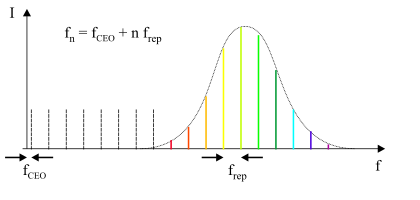Carrier envelope phase
The carrier envelope phase (TE phase, Eng. Carrier-envelope (offset) phase , CE-phase or CEP , CEO-phase ) is a property of a light pulse that is relevant when its duration is only a few periods .
The PD phase is important in generating a frequency comb . Physical effects that depend on the PD phase fall into the area of "extreme non-linear optics ".
PD phase in the time domain

The TE phase is the phase difference between the carrier wave and the intensity envelope of a single light pulse (see figure in the time domain). In a pulse train of several light pulses, it often changes from pulse to pulse, since the phase velocity and group velocity are usually different (the only exception is the vacuum). The TE phase increases from pulse to pulse, for example, until it is greater than 2π. From here the process is repeated. After the time the TE phase has changed by 2π and has the same value as at the beginning due to the 2π periodicity of the trigonometric functions .
PD phase in the frequency domain: The PD frequency
The change in the PD phase over time is described by the PD frequency . The following therefore applies to these:
- .
In the frequency spectrum of a pulse train (see Fourier transformation ), the so-called frequency comb , this PD frequency is expressed as the common offset of all frequency needles (see figure frequency range).






